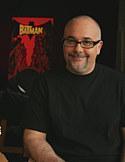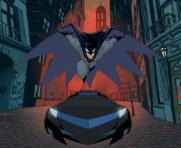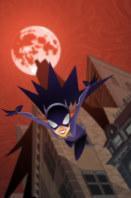|
The World's Finest Presents

MAIN • CHARACTERS • GUIDES • MEDIA • REVIEWS • BACKSTAGE • RELEASES • DISCUSSION
BACKSTAGE - INTERVIEWS
Writer, producer, and story editor for The Batman, Duane
Capizzi has jumped headfirst into the dark world of Gotham. In 2004 he
launched a bold new vision of the Dark Knight, a vision that divided an
audience who still had Bruce Timm's interpretation fresh in their minds. Working alongside designer Jeff Matsuda, this new version of Batman became a
huge hit for Kids'WB!, spawning a new season of episodes and a direct-to-video feature. Capizzi sat down with The World’s Finest to discuss this popular, yet
controversial, animated series.
The World’s Finest (WF): What did it feel like taking on this
series, given the rich animated legacy Batman has?
 Duane Capizzi (DC): It was pretty daunting, since so much has been
done with the character and property -- and done well. With so many years of
comics and a hundred plus episodes of Batman: The Animated Series,
were there any stories left to tell? And mostly, how do we follow in the
footsteps of the towering achievement that is B:TAS? Duane Capizzi (DC): It was pretty daunting, since so much has been
done with the character and property -- and done well. With so many years of
comics and a hundred plus episodes of Batman: The Animated Series,
were there any stories left to tell? And mostly, how do we follow in the
footsteps of the towering achievement that is B:TAS?
Ultimately, the more I revisited favorite Batman works, in both B:TAS and
the comic books, the more I reminded myself that how the story is told is as
important as the story itself -- after all, B:TAS did a lot of tweaking
and reinventing of classic characters and stories, to make them "make sense"
for the version of the mythology they were telling. The task for any writer
and artist team who comes to a classic property like Batman is to freshen it
enough to keep it interesting for fans who are familiar with it, but
obviously not so different that it's no longer true to its source. It's not
unlike jazz: riffing on motifs and themes, recombining familiar elements in
hopefully fresh ways -- while keeping the melody intact.
That said, the idea which really gave form to the task at hand was the "Year
Three" concept. Unlike B:TAS, we thus had the opportunity to unfold an
epic saga which charts Batman's course from vigilante, to working covertly
with members of Gotham P.D., to being publicly accepted as Gotham's hero and
responding to the Bat-Signal, to gaining new alliances and beyond. So, we
could "re-tell" Batman's history in a sequential order, more or less
paralleling the years of Batman mythology -- and hopefully find interesting
ways to introduce a new audience to classic scenarios.
WF: Explain what the goal is with this animated series. I know we
have the press release stating it’s the hip new reinvention of the
character, but in your own words...what are the goals and intentions of this
animated series?
DC: First and foremost, the show was intended for children. Our job
as the creative team is to make it work for the Network and the audience,
but also make the show true to Batman and its fans: obviously, cartoons that
become classics work on more than one level, and we're concerned with
satisfying all fans of Batman. It's a balancing act.
The intention was certainly to give this series a different look from B:TAS,
and to keep the action quotient high. From a storytelling standpoint, we
wanted to tell the stories less from the villains' point of view and more
from Bruce Wayne's. Because we wanted our sympathies to be with Bruce, to
experience his various dilemmas as he grows to become a better Batman, we
made the decision to avoid pathos with the bad guys (at least, on a regular
basis; there are notable exceptions, of course). Also, we consciously made
The Batman more of a "superhero" show. We hit the ground running by having
Batman meet his future arch-villains for the first time -- a
bigger-than-life gallery of grotesques worthy of rising to the Dark Knight's
challenge. The decision was made to keep the villains out of suits and ties,
and keep them in colorful costumes and personalities; weaponry would also be
more fantastical. We also wanted to invoke some of the retro fun feel from
the 60's comics -- elaborate deathtraps and such -- but without getting
campy.
 WF: What kind of challenge is it to work on
The Batman while Justice
League Unlimited and Batman: The Animated Series are still on the air and
readily available? Does it cause any problems while adapting these
characters? WF: What kind of challenge is it to work on
The Batman while Justice
League Unlimited and Batman: The Animated Series are still on the air and
readily available? Does it cause any problems while adapting these
characters?
DC: Mostly, as a result of both JLU and Teen Titans being in first
run, we were conscious of telling types of stories that would be unique to
The Batman, to set our show apart: most notably, we avoid the more
"sci-fi" realm that those shows regularly explore. I view our show more as
"Detective Comics" -- we've hermetically sealed our Gotham from reference to
other superheroes (and 'not-of-this-world' superpowers). It's still "year
three," and The Batman hasn't made their acquaintances -- at least not yet.
In the case of B:TAS, as I earlier alluded, we weren't interested in
simply retelling the same stories the same ways -- what would be the point,
with B:TAS within arm's reach on DVD? So, aware that fans of B:TAS would
be tuning in, the biggest challenge was how to satisfy both them and a brand
new audience. The approach we took was to throw in enough fresh twists and
turns to hopefully keep things interesting.
WF: Can you explain a little bit of the process in writing the pilot
episode “The Bat in the Belfry”?
DC: We didn't want to bog down in too much explanation or back story,
as it needed to be entertaining as a "typical episode" in its own right.
That said, we had to keep a new audience in mind who might not be familiar
with Batman, so there was a lot of introductory ground to cover: setting the
scene in Gotham (Batman wiping out the last of the 'old school' crime
lords), introducing Batman who is in turn Bruce Wayne, introducing Bruce
Wayne's function in Gotham society, meeting Alfred, Joker, Detectives Yin
and Bennett, Chief Rojas -- and make sure we've hit our marks with enough
action set pieces, all in 22 minutes! (there was even a "laughing fish"
homage that was actually animated which sadly had to be cut for time, in the
event anyone wondered if there was an outcome to Joker's gas being dumped
into Gotham Bay).
WF: Nachos and techno music. Some fans actually got offended with
this being in the series. Are little bits of info like Bruce’s favorite food
and having him listen to music an attempt to show us a new side to his
character we’ve never seen before? Do you think you’ve been successful in
bringing that out?
DC: It just seemed natural that if Alfred is going to serve Bruce a
snack in the BatCave, it's going to be nachos or peanut butter sandwiches or
the like -- not foie gras! I think that in our collective memory, Bruce
Wayne is a dashing guy in a tuxedo who drives a fast car. I wanted to make
explicit that the swinging bachelor part of Bruce's personality is an act
that he puts on, in order to cover any suspicions that he might be The
Batman. Therefore, Bruce eats caviar when he's putting on a show for the
public eye, but I don't think it's his choice of snack when at home.
As for the "techno" (presumably you're referring to what was playing at
Bruce's party in "Call of the Cobblepot"?), again, that would fall into the
category of the persona Bruce puts on for the public. He's a young
billionaire: when HE throws parties they're not going to be black tie
affairs with polite company; rather, he's going to throw a rave and invite
the Hollywood crowd.
WF: Can you explain The Batman’s approach to showcasing the bad guys?
 DC: In the case of classic rogues, we stayed true to their
conceptions while giving them "makeovers." In the case of more obscure
villains (e.g., Cluemaster, Ragdoll, etc.), we took more leeway in
reimagining them. DC: In the case of classic rogues, we stayed true to their
conceptions while giving them "makeovers." In the case of more obscure
villains (e.g., Cluemaster, Ragdoll, etc.), we took more leeway in
reimagining them.
For the most part, we wanted to focus on what the villains DO -- not
necessarily where they came from. Simply put, we avoided telling "origin"
stories, unless we had compelling enough reason to. Our Mr. Freeze is, of
course, a good example. 'Heart of Ice' from B:TAS is such a masterpiece,
why try to top it? And it would be futile to remake it. So, we chose to turn
Victor Fries from a hot-headed thug to a cold-hearted monster, an
emotionless mutant. More than Freeze himself, what made the story
interesting, in my opinion, was Batman's reaction to Freeze -- we were able to explore
Batman's feelings of guilt and doubt: was he responsible for creating
Freeze?
In the case of Penguin, we provided him with a true back story without having
to tell a literal origin: you pretty much learn all you need to know about
him as Bruce/Batman learns it, in the course of the episode (a structural
device we also utilized for Cluemaster and Ventriloquist, for instance). I
feel we really conjured one of the more interesting depictions of Cobblepot
-- he's the anti-Bruce, since he sees himself as handsome and wealthy but is
in actuality homely and his family fortune has long since fallen into a
state of decay to match Ms. Haversham's. Coupled with connecting his past to
the Pennyworth family, Penguin's now as inextricably linked to Bruce Wayne
as Joker is to The Batman! (note that in the sequel, 'Bird of Prey,'
Penguin's out for revenge against Bruce Wayne, not Batman).
Joker's past may currently be an enigma of sorts, but if you follow our
Joker's trajectory in series, we're trying to make him as "dangerous" as we
can: starting with Bennett, Joker is responsible for harming those closest
to Bruce/Batman.
However, as with Clayface, there will be exceptions to the 'avoid origin
stories' rule: for example, we will be telling a compelling "real time"
origin story for Poison Ivy, in our two-part Season Premiere on Sept 17.
WF: What spawned the idea to turn Ethan Bennet into Clayface? Was
that an idea placed since day one of the series?
DC: Yes, it was there from day one. We knew there would be an
exception or two to the "save the pathos for Bruce Wayne" mission statement.
So, in the case of Clayface, we "snuck" his origin by the audience without
them knowing, little by little, all season long. Judging by fan response,
apparently it worked! The two-parter served a lot of purposes: not only did
Batman lose a friend but gain an ally at Season's end, the episode
positioned Joker as Batman's true nemesis -- their conflict deepened,
because of the loss inflicted to Batman.
WF: Both seasons have ended on status quo changing notes. The first
season ended with Bennet becoming Clayface, the second with the introduction
of Gordon. Is this done to keep the series from getting stale? Why?
 DC: We aren't concerned about the series "getting stale" -- not with
so much more Bat-mythology to draw from! Rather, I refer back to the "saga"
aspect of our series: while all our episodes (with the exception of the two-parters)
are "stand-alone," there IS an arc running throughout, which charts Batman's
progress from vigilante (Season One) to covertly working with a trusted
silent partner in Gotham P.D. (Season Two) to being Gotham's hero and
gaining new alliances (Season Three and beyond). It's natural to use Season
Finales as "special event" episodes, to both close the book on a particular
chapter of Batman's development and begin another. We used the Season 2
finale, 'Night and the City,' to tie up loose ends with Yin, Rojas et al,
while introducing Gordon and paving the way for the Bat-Signal and Batgirl. DC: We aren't concerned about the series "getting stale" -- not with
so much more Bat-mythology to draw from! Rather, I refer back to the "saga"
aspect of our series: while all our episodes (with the exception of the two-parters)
are "stand-alone," there IS an arc running throughout, which charts Batman's
progress from vigilante (Season One) to covertly working with a trusted
silent partner in Gotham P.D. (Season Two) to being Gotham's hero and
gaining new alliances (Season Three and beyond). It's natural to use Season
Finales as "special event" episodes, to both close the book on a particular
chapter of Batman's development and begin another. We used the Season 2
finale, 'Night and the City,' to tie up loose ends with Yin, Rojas et al,
while introducing Gordon and paving the way for the Bat-Signal and Batgirl.
WF: Anything to say to the fans who have been around since day one,
and even the new ones who jumped on with season two? What can we expect in
the upcoming season of The Batman? How do you plan to bring viewers back in?
DC: I think you'll enjoy what lies ahead as our characters continue
to grow. Of course it's no secret by now that we'll be introducing
Commissioner Gordon's daughter Barbara, and thus Batgirl, in our compelling
two-part season opener. And I'm convinced you will LOVE how we handle Poison
Ivy, and the ways we link her to Batgirl -- it was definitely one "origin"
story worth telling! As with the other classic rogues, Ivy will be
different, yet the same. If anything, her powers are way more INTENSE!
You'll be seeing some of our original villain creations this season:
Temblor, Cosmo Krank, and Gotham's Ultimate Criminal Mastermind, "Dave.”
There will also be re-imaginings of Maxie Zeus and Gearhead, things will
kick up to the next level between Batman and Hugo Strange, and our
"double-headers" will continue to be interesting as Catwoman meets Joker,
and Penguin meets Freeze. So tune in!
WF: Take us through the current production state, why the show isn’t
cancelled, waiting for episode pick-up, and just what it means for The
Batman.
DC: I think fans of Batman will love 'The Batman vs. Dracula'
Direct-To-Video feature (due to hit the shelves in mid-October, just in time
for Halloween). I promise that there is at least one sequence that will blow
your minds! We are now in post-production on our 3rd set of 13 episodes of
The Batman.
I hope this was an informative glimpse into our creative process on The
Batman, and hope you enjoy our upcoming season and DTV feature.
[Back to Backstage]
Check out much more at The World's Finest.
The Batman and all characters and related indicia are (c) and TM of their respective owners.
Original content, copyright The World's Finest. Contact us.
Follow The World's Finest on
Twitter - Facebook - YouTube
|